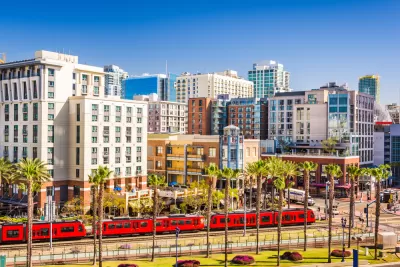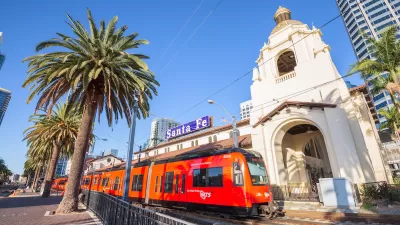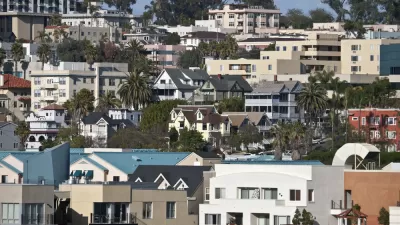In response to conservative opposition to a proposed road user charge, San Diego's regional planning agency is proposing other revenue sources including a tax on ride-hailing and three sales tax increases.

The San Diego Association of Governments (SANDAG) is scaling back its long-term transportation plan due to opposition from conservative leaders who disagree with a proposed road user charge, reports Andrew Keatts.
Opponents claim that the agency doesn't have the legal authority to enforce the charge, putting the programs that would depend on funding from it at risk. According to Colin Parent, Democratic councilman from La Mesa, "unlike a sales tax ballot measure, there’s no legal authority to do it, and unlike a ballot measure there’s no historic precedent for having done it – either locally or elsewhere." Planning for projects funded with a new source of funding that requires new legislation, argues Parent, means the agency is planning work it might never have the revenue for.
Meanwhile, the plan does propose some more traditional funding sources:
- Three sales tax increases to fund transportation improvements.
- Per-ride fees on ride-hailing companies. In addition to bringing in a projected $1.3 billion, the fee is designed to discourage the "emissions-intensive" trips.
- Managed toll and bus lanes on the region's highways, which could bring in over $19 billion. To create the new managed lanes, the agency plans to convert existing lanes as well as expand freeways to build new ones.
FULL STORY: The Other Big Tax Expectations in SANDAG’S New Plan

Alabama: Trump Terminates Settlements for Black Communities Harmed By Raw Sewage
Trump deemed the landmark civil rights agreement “illegal DEI and environmental justice policy.”

Study: Maui’s Plan to Convert Vacation Rentals to Long-Term Housing Could Cause Nearly $1 Billion Economic Loss
The plan would reduce visitor accommodation by 25% resulting in 1,900 jobs lost.

Planetizen Federal Action Tracker
A weekly monitor of how Trump’s orders and actions are impacting planners and planning in America.

Waymo Gets Permission to Map SF’s Market Street
If allowed to operate on the traffic-restricted street, Waymo’s autonomous taxis would have a leg up over ride-hailing competitors — and counter the city’s efforts to grow bike and pedestrian on the thoroughfare.

Parklet Symposium Highlights the Success of Shared Spaces
Parklets got a boost during the Covid-19 pandemic, when the concept was translated to outdoor dining programs that offered restaurants a lifeline during the shutdown.

Federal Homelessness Agency Places Entire Staff on Leave
The U.S. Interagency Council on Homelessness is the only federal agency dedicated to preventing and ending homelessness.
Urban Design for Planners 1: Software Tools
This six-course series explores essential urban design concepts using open source software and equips planners with the tools they need to participate fully in the urban design process.
Planning for Universal Design
Learn the tools for implementing Universal Design in planning regulations.
Caltrans
Smith Gee Studio
Institute for Housing and Urban Development Studies (IHS)
City of Grandview
Harvard GSD Executive Education
Toledo-Lucas County Plan Commissions
Salt Lake City
NYU Wagner Graduate School of Public Service





























